🤓 The 2026 Local Search Ranking Factors are here!! Check out the report!
🤓 The 2026 Local Search Ranking Factors are here!! Check out the report!

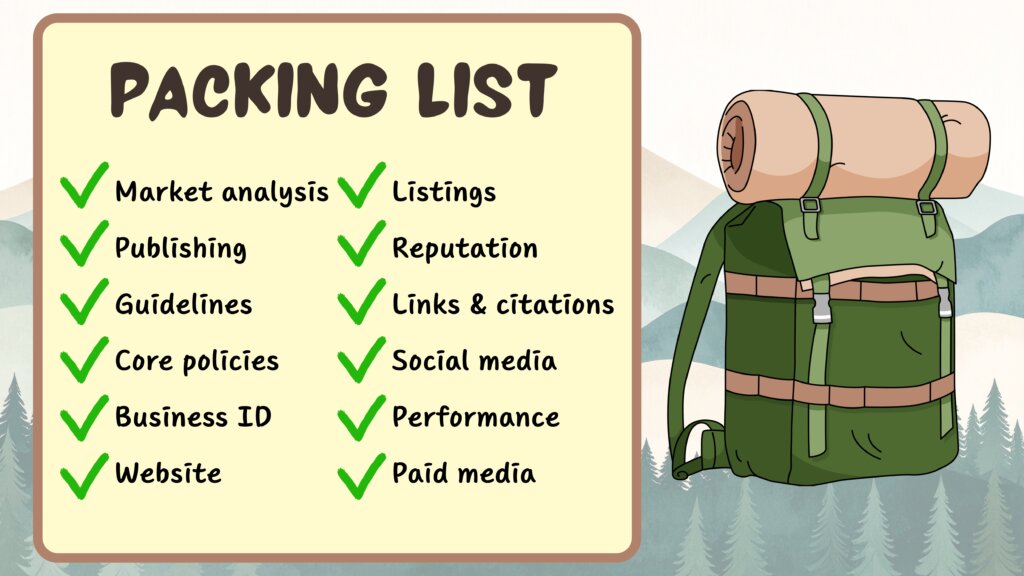
What are all the components of a complete local search marketing strategy for your small business? You’re going to learn that today with this guide, giving you a clear picture of all your opportunities for promoting your brand both online and offline to the public. Each topic has been distilled down to the basics you need to know first, most, and best for a crash course on this very broad topic. Be prepared to learn a lot over the next few minutes!
🤔 Why you can trust this guide
The web is full of low-authority local search marketing advice and some of it is actually pretty misleading. By contrast, this guide has been authored by me, a Local SEO Subject Matter Expert with 20+ years of experience. I want you to think of me as your own personal guide who is about to take you on a backpacking trip. I’m going to tell you everything you can choose to pack for the best possible hike through the woods and up the mountains of modern local search marketing. Our goal is the success of your business over the coming weeks, months, and years.
🫵 This guide is for you if…
You are marketing your own small local business or the small local businesses of your agency’s clients. This guide speaks to single and multi-location brick-and-mortar brands and service area businesses. If you or your clients serve the public face-to-face, this guide is for you. Let’s get packing!
If you can pack all 12 of the following components for your local search marketing journey over time, you’ll be running one of the strongest businesses in your town or city. Read them in order for a full education, or jump to any section that interests you most using the Table of Contents on the left.
If you’re reading this guide because you’re involved in the planning phase of launching a new local business, your local search marketing strategy can begin long before the company opens its doors for a much stronger start. Even if the brand you’re promoting is already up-and-running, you still need a plan for understanding these three major local commercial realities:
Google is the dominant local search engine, so you need to start with a clear understanding of how they see your market. Go to Google.com/maps and look up the name of the town or city in which your business is located to see how they define the borders, as in this example of the town of Monterey, California:
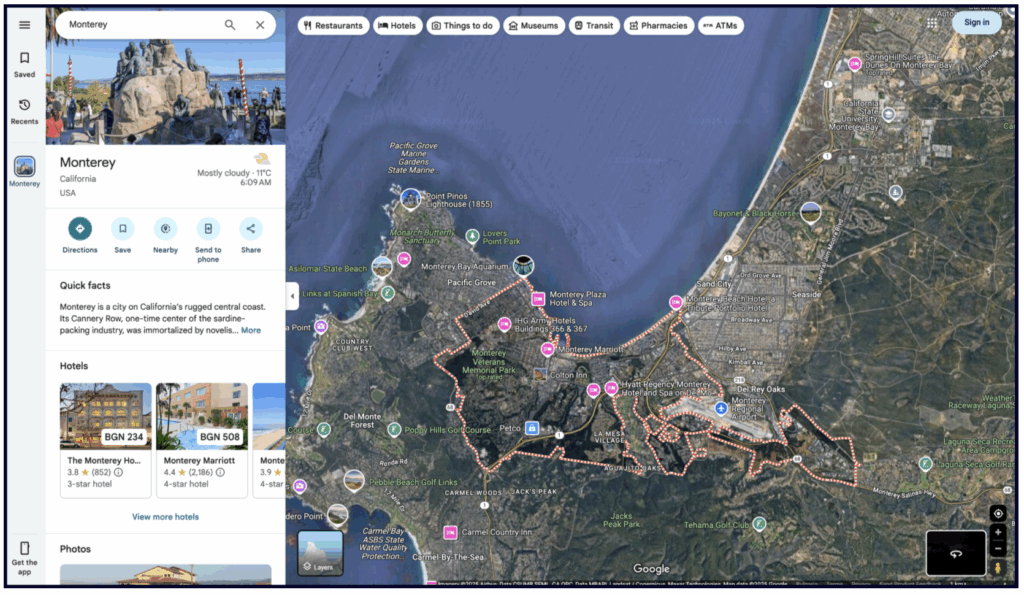
Why does this matter? Because if you want to serve the community within Google’s mapped border, the business you’re marketing will be far better off if its address is inside the given perimeter. If your business is located outside the border, it will be at a disadvantage when it comes to ranking in Google’s 3 main local interfaces, which are: Google Maps, Local Packs, and the Local Finder interface, which searchers are shown when they click on Local Packs.
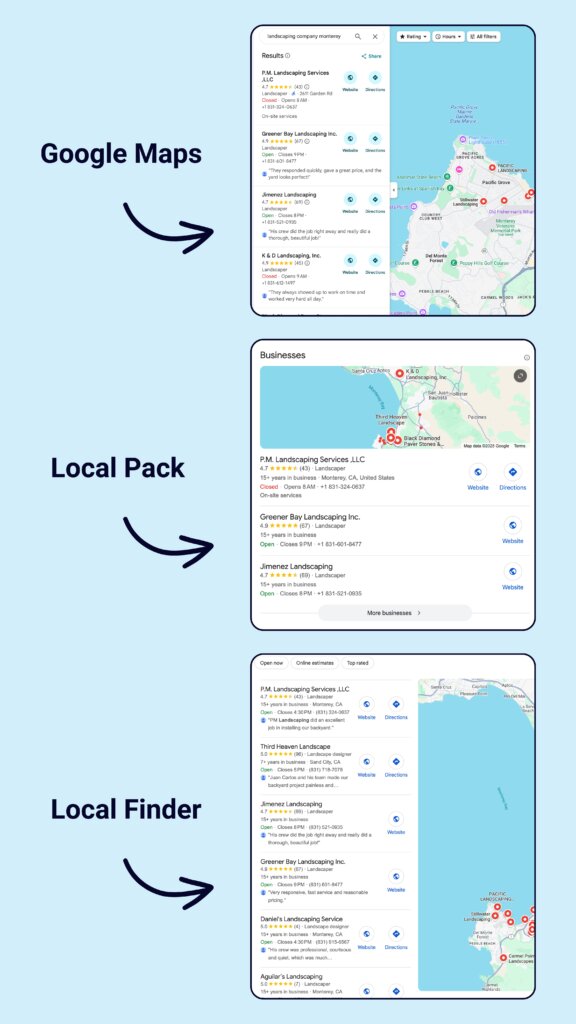
Where you locate your business is critical. Whether you are running a business from home or from a brick-and-mortar location, choice of address is one of the most important first decisions you can make to help you be seen in Google’s various local search results by the customers you want to serve.
If you are considering or are already established at an address that falls outside the Google borders of the community you want to serve, you may need to change your location in order to achieve maximum visibility in your desired market. This principle holds true for single-location businesses and each location of multi-location businesses.
Unless the business you’re promoting is literally the only one of its kind serving a given market, you need to know and study your top local competitors so that you can create a strategy for competing with them (and hopefully for surpassing them) in Google’s local results.
Your research into the competitive landscape needs to be based on one key fact: your customer is the nexus of your market.
💡 Whether your customer is looking for businesses like yours on their laptop or mobile device, Google will use their physical location to customize the results they see. They will see one set of results while searching from home, and another if they walk to a different neighborhood or drive across town. This reality is sometimes referred to as the “user being the centroid of search”.
You have two options for capturing the phenomenon as part of your market research:
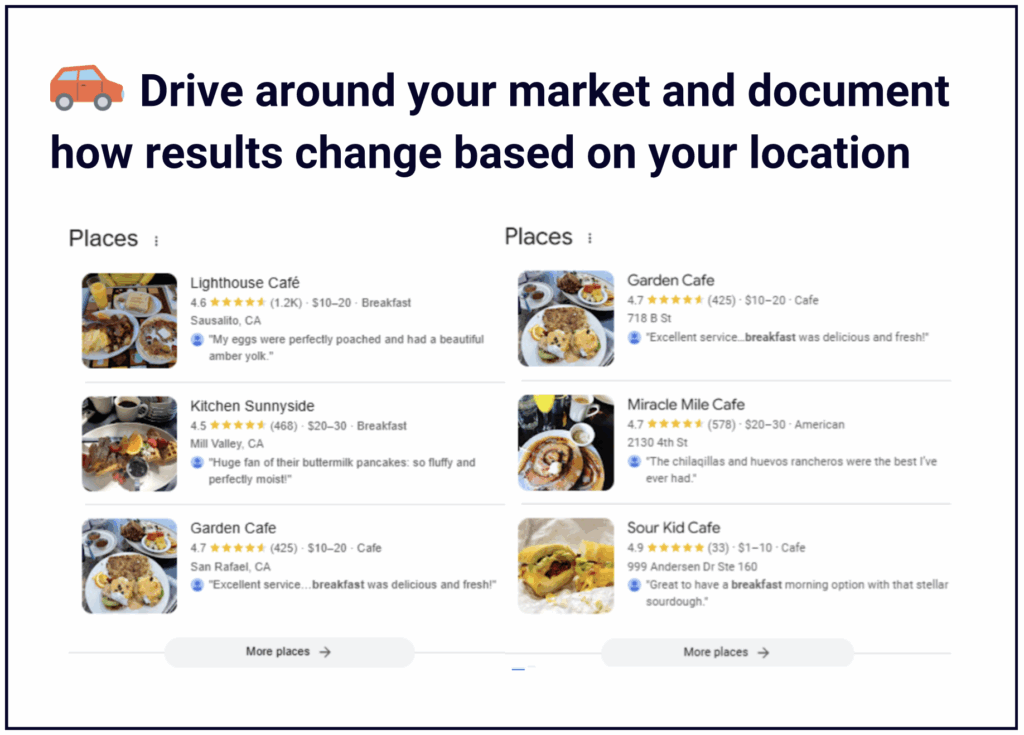
Start by searching for your most important search term from your established or proposed business address. In the above example, we’re imagining you’re opening a breakfast restaurant and your most most important search term will be “breakfast + your city name”.
Document your top competitor for that phrase while you’re at your place of business (in this case, Lighthouse Cafe) and then take a short drive away from your business and do the same search on your phone. As you can see, Garden Cafe becomes your top competitor once you’ve moved even a short distance away.
Next, drive a bit further away and keep repeating the process until you’ve covered what you think of as a reasonable distance from which customers might come to you. You can stay within Google’s city borders or go outside of them as well for a bigger sampling.
The end result will be that you will have a list of the top-ranked businesses based on user location. These are the competitors you will have to out-market to surpass in the rankings, and it’s worthwhile to do this experiment at least once manually, but competitive research is an ongoing marketing task, and this manual approach is cumbersome. So, that’s why option two exists.
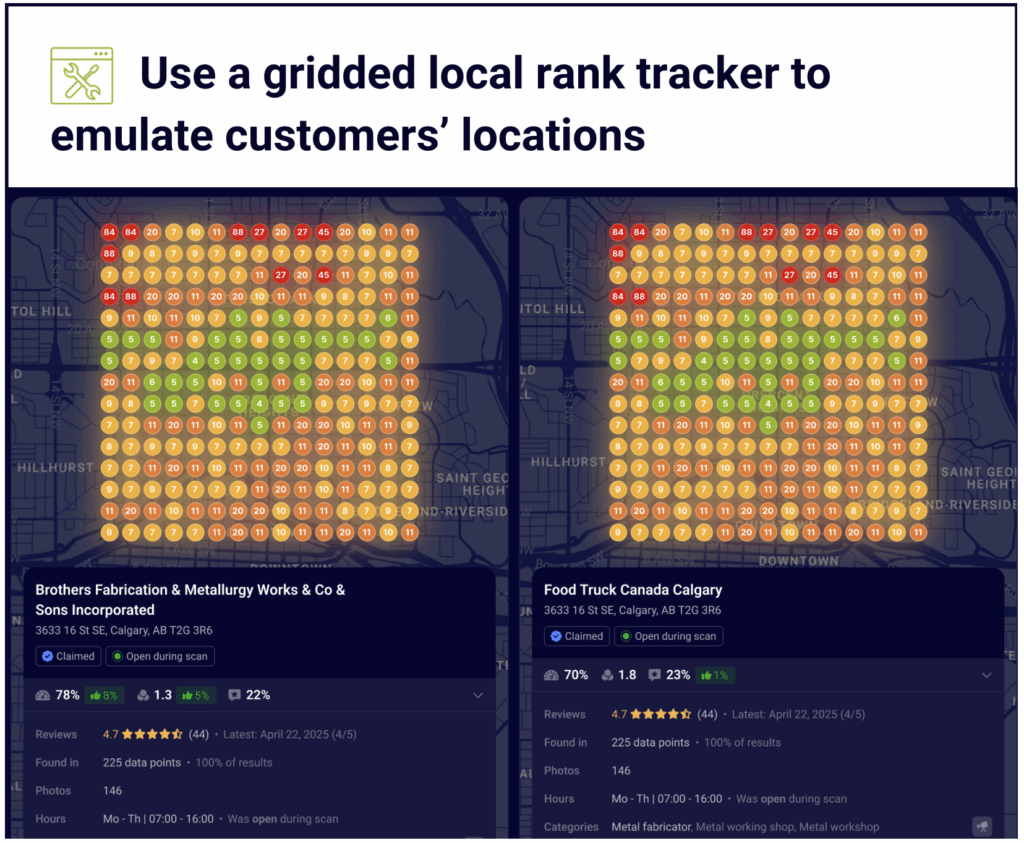
There are a variety of gridded local rank tracker tools that will let you emulate a location on the map to understand who is ranking highest in Google’s Maps or Local Packs for your important search phrases. The tool pictured above is Whitespark’s Local Ranking Grids.
Emulation allows you to easily research your market at any time to see both who your top competitors are in different locations as well as to see if your own performance is improving over time.
When you have a list of your top competitors, you can conduct a formal audit of them that reveals clues as to why they are enjoying such high visibility. You can research metrics like their:
This guide will not teach you how to conduct a full competitive audit, but you can begin learning about known local search ranking factors from Whitespark’s annual Local Search Ranking Factors report.
💡 By analyzing your competitive landscape, you can identify how factors like your address and marketing efforts are measuring up to the top competition, and create a strategy for surpassing your peers on as many metrics as possible in hopes of increasing your local search visibility, user behavior signals, conversions, and sales.
Before you launch a new local business, and for the entire time you are serving the public, your greatest security will reside in meeting existing consumer demand in your market. All too often, small local businesses fail because they are based on concepts for which there isn’t sufficient local demand.
For example, a small town may already have 3 BBQ restaurants that are earning just enough business to be solvent. Unless there is something so different and superior about your BBQ recipes, it would be a risk to assume that there is enough demand in the community for a fourth identical eatery.
You will increase the chances of your business succeeding if you base your business, its products, services, offerings, and policies on exactly what your neighbors say they want. Get a sense of demand by:
While skilled marketers can create demand around novelty concepts that the public never realized it wanted, you will have more confidence in your business plan and promotion if you’ve taken the time to identify what your community wants and how it wants to be served.
Just as real-world businesses have always published a tremendous variety of print materials (think brochures, menus, mailers, billboards, signage, etc.), local businesses become digital publishers the moment they step online.
Publication spans an exciting array of options, including websites, local business listings, social media posts, blogs, and so much more. Whether you are marketing your own business or the brands of clients, it will help to envision strategy as a multimedia effort from the get-go. Local business publishing can take all of the following forms:
Textual Media
Whether on or off the web, every word a local business publishes matters. Text-based media includes:
For maximum impact, all textual media representing your business should be optimized to match the intents of your potential customers and the language in which they speak and search. Your consumer polls and surveys, mentioned above, can help you understand not only what customers want, but how they speak about and use the internet to search for their needs.
Research into this should be coupled with online keyword research tools to help you capture how searchers phrase their searches. There are many such tools on the market, including both free and paid keyword research subscription software.
In addition to using keyword research tools, you can go right to Google to look up search phrases related to your products and services, and check out SERP features like the “People also search for” results Google brings up for many searches:
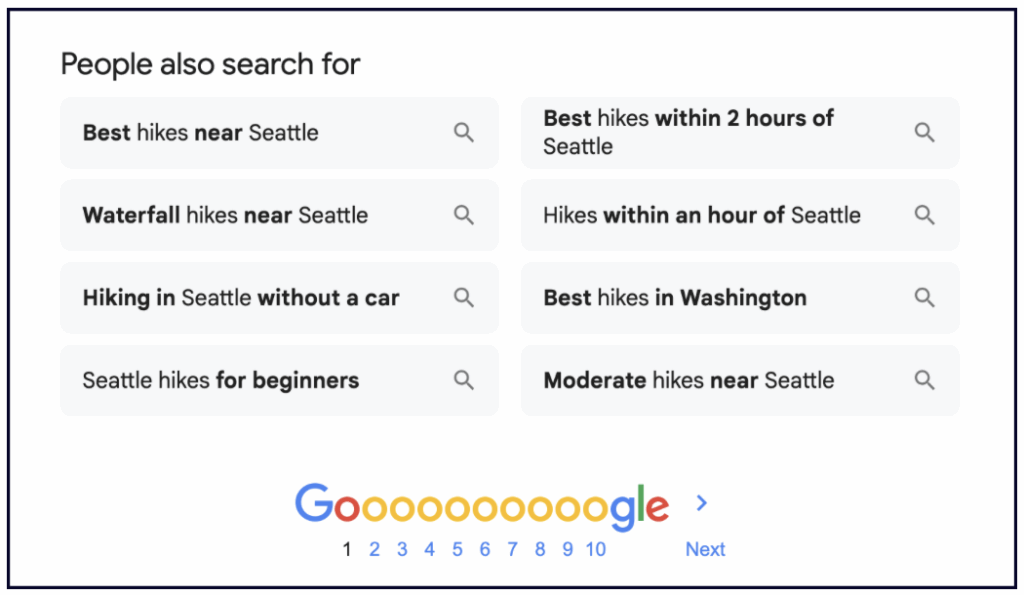
A core task of search engine optimization (SEO) is ensuring that all of the text a local business publishes has been optimized to reflect the variety of ways in which people phrase their searches in hopes of meeting a specific intent, like finding a good restaurant that serves vegan food, locating a trustworthy doctor, or booking an appointment to have their carpets cleaned.
💡 The more closely your array of textual content matches searchers’ language, the better your chances of Google believing that your business is a relevant result for each searcher.
Visual Media
This vital component of your marketing consists of:
As with your textual content, video content should be optimized around consumer demand and search language. The video strategy for each business will be unique. For example, some local businesses will exist in an industry in which a video blog (vlog) would be a strong asset, while other industries may contain little or no demand for such content.
At the very least, all local businesses should aim to film the aspects of their business that are of most interest to consumers trying to choose a nearby company to transact with, and then publish this content on assets like the company’s website, local business listings, and social media profiles.
Audio Media
Your opportunities include:
As with visual media, demand will differ based on industry and community. For example, launching a podcast could set a local brand apart in a tough market, but if there is not enough interest in an ongoing podcast on the business’ topic, the owner can still seek opportunities to appear as a guest on third-party local and industry podcasts to build brand awareness and authority.
Just as local businesses have to comply with federal and state laws and local codes and statutes in their operations, there are both laws and guidelines applicable to online marketing. Every third-party platform on which you might promote a local business will have policies you should adhere to in order to avoid adverse outcomes, such as having your local business listings suspended or being banned from an online community.
Before you begin marketing in any third-party space, read its guidelines. Here is a short list of guidelines needed by nearly all local businesses:
Whether you are joining a private community like a Discord server or a public social media hub like Facebook, you will save yourself from embarrassment, wasted time, and penalties by complying with any guidelines published by the platform.
It’s a poorly-understood commercial reality, but the dominant factor in whether a local business can market itself well and earn longevity is the quality of its customer service. Satisfied customers:
Because the key to getting to stay in business is keeping customers happy, company practices and policies should be based entirely around this goal. This includes:
Make no mistake about it: customer-centric businesses have a significant local search marketing advantage over less-motivated competitors. Don’t shortcut the thought that needs to go into the policies that dictate how your brand will treat its community.
Every local business has a digital footprint made up of some or all of the following elements:
Before you engage in any marketing activity (such as creating local business listings or developing website landing pages), you should codify and document as many of the above fields as possible for each location of the brand you’re promoting. If you are working with a multidisciplinary team, or multiple teams, be sure all relevant players have access to a core document containing current and accurate information for each of these fields. This will avoid cumbersome and costly mistakes being made as you move forward with marketing the business.
If aspects of the business change, such as new locations opening, temporarily or permanently closing, moving, or changing phone numbers, be sure the core document is updated.
Even the websites of small local businesses can grow over time to contain hundreds or thousands of pages, but it helps to start out with a clear plan for covering core needs at launch. Most local businesses can use the following outline of essential pages to publish version 1.0 of their website:
Some businesses start out so small that they may need to begin with a single page website. If that’s the case with a brand you’re marketing, try to cover as many of the above assets as possible within the page, with plans to grow the site over time.
Some of your less-motivated competitors will shortcut the work it takes to build a strong website and will throw any kind of content up on their domains. If your goal is to market the best business in town, now is the time to acquaint yourself with Google’s acronym E-E-A-T, which stands for:
Experience – Your content should be based in either first-hand or life experience with the topic being covered.
Expertise – Your content should be written by the most authoritative experts at your company
Authoritativeness – Your content should be recognized and cited by others as an authoritative source of information for the topics covered.
Trustworthiness – Your content should cite factual sources and should offer a secure environment with modern HTTPs and SSL certifications, consumer guarantees, and accurate contact information.
E-E-A-T represents a set of criteria Google provides its Quality Raters workforce, whose job it is to evaluate whether the search engine is returning relevant results to searchers. While E-E-A-T signals should not be considered direct ranking factors, they are good guidelines to keep in mind for vetting whether the content you are publishing and marketing would be considered of high or low quality by Google, its Quality Raters, and the public.
All pages of the site should be optimized on the basis of your customer research and search query research, so that every form of multimedia content is designed to match the intents and language of your community. Don’t make the mistake of thinking Google will magically understand where a business is located or what it offers. Instead be sure these basic fields of the site contain the key phrases for which you’re seeking visibility:

The URL (like www.appliances.com/washing-machine-repair-san-rafael) of every page you publish on the site should reflect the findings of your search query research and customer research. A good plan for most local businesses is to be sure that the URL of any given page contains a combination of the product/service being offered or concept being covered + the city in which it is available.
Most website builder software will have a “title tag” field and you should create a unique one for each page you publish, reflecting the findings of your search query research and customer research as they relate to the topic being covered on the page. General best practices for title tags have long included a length recommendation of about 50-60 characters, but bear two things in mind:
✍️ Title tags are strongly believed to have a direct impact on your search engine rankings, and it is worth the time to craft them with care.
Most website builder software will have a “meta description” field and you should create a unique one for each page you publish, reflecting the findings of your search query research and customer research as they relate to the topic being covered on the page. While the contents of your meta descriptions are not believed to directly impact search engine rankings, they can have a big effect on user behavior, which does impact rankings.
In the above example, the meta description portion of this entry in Google’s results is the part that begins “Need appliance repair in San Rafael?” If your meta descriptions strike searchers as more appealing than those of your competitors, causing your entry to receive more clicks than other entries are receiving, this could cause your page to begin to outrank the competition. Because of this, meta descriptions should be thought of as elevator-pitch-style marketing elements that offer a brief but persuasive appeal to the user to click through from the SERPs (search engine results pages) to the website.
General length best practices for meta descriptions typically fall within the 150-160 character range, but this can vary across devices. As with title tags, it is very common for Google to generate a custom meta description (instead of using the one you’ve written) if they think it will better match the intent of a searcher. Nevertheless, it’s still worth the time to craft a unique meta description for each page you publish, using it as a marketing pitch for the topic being covered by that page.
The header tag at the beginning of the page content in the above example reads, “Reliable Appliance Repair Experts In San Rafael”. While header tags were believed to have a strong and direct impact on the search engine rankings in the early days of SEO, Google’s more recent public position has been that they are merely another element that helps them understand the contents of website pages.
Best practices include thinking of headings and subheadings as ways to introduce and then break up the content of a given page so that it is more digestible and helpful for website visitors. Optimizing these elements with the findings of your search query and customer research is just a natural way to ensure that you are using the terms and language that people in your community use when looking for what a brand like yours offers.
The main body of each page you publish is where the bulk of its content will reside. Text content should be optimized to reflect the findings of your customer and search query research in a natural manner. It is not necessary or wise to publish content with robotic-sounding language that repeats queries in a way humans don’t speak. Instead, write text content with the goal of answering all possible questions your community might have about your products, services, policies, and business while ensuring that you are using the language they use when they speak and search.
Page content can be made up of multimedia offerings, including text, images, video, and audio elements, and a best SEO practice is to ensure that every page you publish has a clear call-to-action (CTA). CTAs guide the visitor to a next step you are hoping they will take, such as clicking to a further page for more information, filling out a form, booking an appointment, or picking up the phone to call you.
And always remember that in the local business context, location search queries matter. Be sure the user can understand from each page’s content that the business is either located at a specific address or serves a particular service area.
Most website builder software will have an “alt text” field available each time you include an image in your page content. While search engines like Google are becoming increasingly sophisticated at understanding image content, it is still a best practice to write alt text for every image you publish. These elements are essential for potential customers with low vision or blindness to be able to understand your image content via screen reader programs. Be sure you are serving everyone in your community by briefly, but succinctly, describing what is shown in each image you publish.
In addition to the six elements shown in the above graphic, your on-page SEO should also include care for the following best practices:
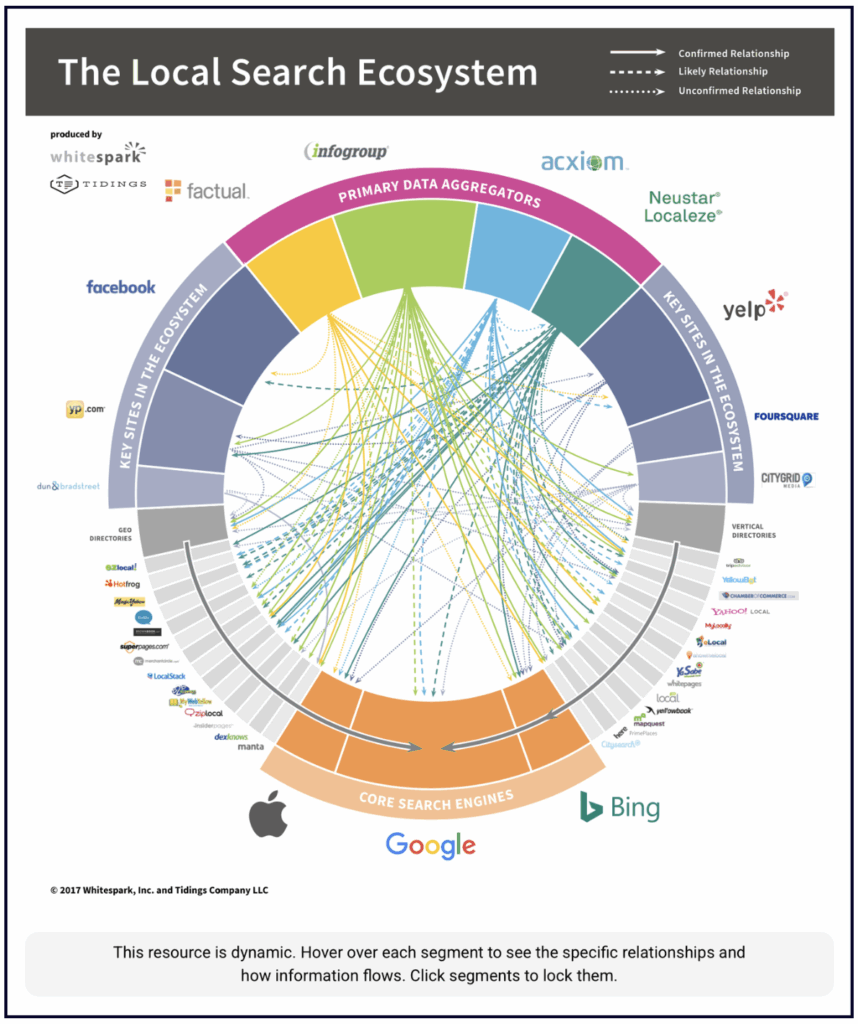
Once your local business website has launched, the wealth of off-site marketing opportunities commonly known as the “local search ecosystem” awaits you. Listing platforms like Google Business Profiles, Apple Maps, and Yelp exist to provide consumers with a searchable index of local businesses and getting listed in these systems and sites is typically free.
The information you gathered in the “Your Business ID” phase of work really comes into play here, as you create listings with as much rich information on them as possible on general platforms like:
Depending on your industry, you can also get listed on industry-specific local business listing platforms like:
In addition to this, there may be local business directories specific to your town or city where you should get listed to increase your visibility.
Listings on official local business indexes like the above are sometimes referred to as “structured citations” – meaning that they are formal mentions of your business’ name and contact information. The chief benefit they provide is an additional path for consumers to discover the brand you are marketing, apart from its website.
Each platform has unique guidelines and styles of local business listings, and local businesses are likely to spend the most time focusing on their Google Business Profiles (GBPs) because inclusion in Google’s local index is what results in visibility in their local packs, local finders, and Google Maps.
💡 Google’s influence in local consumer journeys is second-to-none, and exceptional care should be taken to create guideline-compliant, fully complete GBPs.
Meanwhile, a product like Apple Business Connect has the benefit of Apple Maps being the default local search application on millions of iPhones. LinkedIn is experiencing a recent boom in popularity in professional circles, likely due to a decrease in the popularity of the social media platform X, and while it might not be the first place a customer would go to find a local business, having a LinkedIn presence could be a necessary component in building B2B credibility.
The overall point here is that the local businesses you market should get listed on platforms that are used by the public and should not worry too much or invest too much time or money in creating profiles on sites that are seldom seen or used by real human beings. Any listing you build should be filled out as fully as possible to create the most informative experience for potential customers. While listing fields vary across platforms, be ready with the assets you gathered in the “Your Business ID” section of this guide when you enter this phase of marketing your business via local business listings.
Gathering all of your business ID (including contact information, photos, videos, etc.) is the first step in this marketing process. Your subsequent steps will include:
Each local business listing platform has its own process for listing submission, verification, and ongoing management, and you have 2 core options for how you will approach this major local search marketing task:
Your company or agency can choose to manually create all of your listings by going to each platform one by one, manage all verification steps in-house, track the status of all of your listings in a spreadsheet or a database, and handle all ongoing management tasks on a daily basis without assistance from other tools or teams.
Pros: This approach gives you maximum control of your local business listing assets without having to budget for or contract with third-party marketers or software providers. If your business is under-funded at the moment, a manual effort may be necessary to get you started.
Cons: While manual management may provide maximum in-house control of your listings, it is vital to know that you never own your listings; they belong to the platforms on which they reside, and these companies can be very difficult to communicate with on your own without professional assistance when things go wrong. Meanwhile, the more complex the local business model, the less efficient manual listing management becomes.
Whether you have a single local business in a competitive market that needs to put maximum effort into its marketing, or you have a multi-department, multi-service area, multi-location or multi-practitioner model, manual management simply does not scale effectively to keep listings optimally accurate and interactive over time.
Your company or agency can choose a professional partner like Whitespark to get your listings created and verified on the platforms that matter most to you, and can make use of services to help you make the most of the extraordinary opportunities and complexities posed by Google Business Profile management.
Pros: This approach allows you to make a professional investment in getting properly listed across the parts of the local search ecosystem that matter most to a specific brand and its customers. By choosing a partner like Whitespark, you will have the confidence of knowing that your citations around the web have been cleaned up so that consumers aren’t being inconvenienced by misinformation giving them a poor impression of brand reputation, and that the brand you are marketing has been expertly listed in all the right places. An assisted approach typically provides a massive savings in time for your teams.
Cons: While this approach saves you time, it does require an investment, which under-funded startups may find challenging. There are multiple local business listings creation and management services out there on the market today. Be sure you are carefully evaluating any partnership you are considering so that you are not being charged for the development of citations on platforms that have little or no visibility to your potential customers.
Also, take into account the rate at which your business will need to update its listings for basic contact information changes, content postings, and review responses. Small business needs in this regard differ from the needs of large enterprises with hundreds or thousands of locations. Put in the research to find a good partner for your needs.

Some listing platforms (like Yelp and TripAdvisor) have an extra strong focus on local business reviews, but the truth is that reviews tend to make up the most interactive aspect of listings on any platform. Wherever reviews exist, local businesses need a reputation management plan for:
With the notable exception of Yelp, nearly all listing platforms allow you to ask your customers to review you, so long as you don’t offer any type of incentives for their reviews or put their reviews through a “review gating” system which suppresses publication of less favorable sentiment. Most local businesses should be actively asking for reviews in-person, via email, and text messages.
✍️ Review acquisition should include earning reviews both on third-party platforms (like Google Business Profiles and Yelp) and as first-party content the brand publishes itself on its own website and other marketing assets.
Whether you are marketing a single-location business with multiple listings across its local search ecosystem, or multi-location, multi-department, or multi-practitioner listings with each entity having its own set of reviews to manage, you need to know when fresh reviews come in so that consumers can receive a timely response from the brand.
The overwhelming majority of consumers now consider brand owner responses to reviews to be part of offering good customer service. Brands must respond quickly and authentically to reviews, offering thanks where praise is given or offers to make things right for customers who are dissatisfied. Owner responses to reviews are one of the most effective forms of local search marketing, signalling that the brand is accessible, treats its customers well, and is eager to receive reviews from the public.
Reviews are one of the most useful, free sources of business intelligence possessed by any local business. They are a quality control metric that lets the brand know whether it is succeeding at customer satisfaction across all of its locations over time. Review sentiment should be analyzed for both positive trends in response to business offerings and negative trends which indicate that improvements are required to restore customer satisfaction at any given branch of the business.
Unfortunately, all review platforms are subject to bad actors either positively reviewing the brands they are trying to promote or negatively reviewing competitors in an effort to damage their reputation and rankings. Local businesses need to monitor their own profiles and those of their top competitors for indications that reviews are being left that violate platform guidelines, and in most cases, such content can be reported to the platform for evaluation and possible removal.
Multiple consumer surveys indicate that consumers trust what customers say about businesses more than what brands say about themselves. Because of this, review content should be viewed as a re-marketable asset which can be highly featured in various components of listings (like the image and video section of Google Business profiles), and on the website, social profiles, and multiple forms of advertising and signage of the business. This is all the more reason that reviewers should be treated with gratitude and care – they are the best free salesforce most local businesses could ever have!
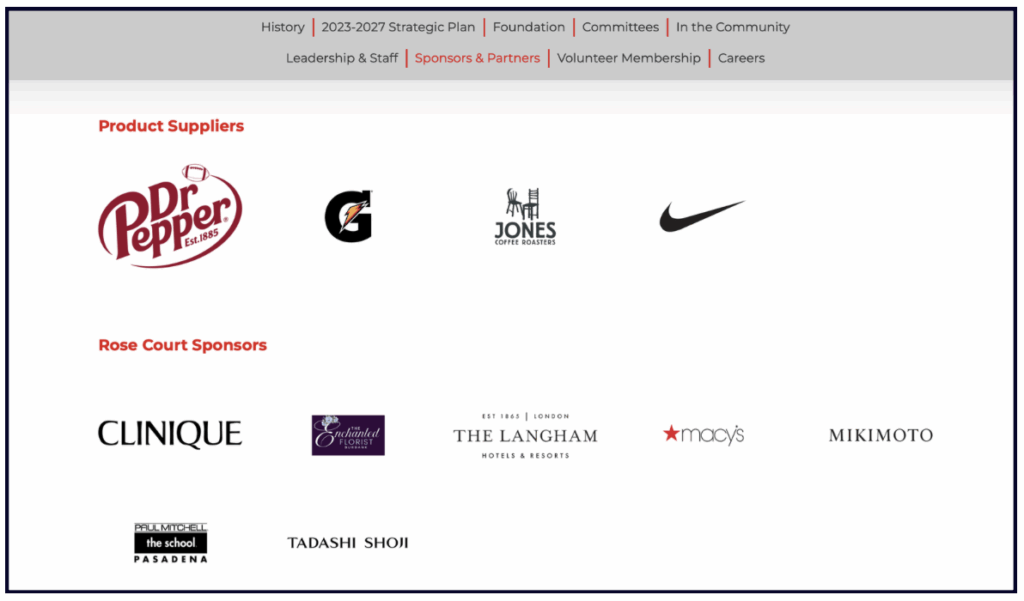
In addition to building formal local business listings (a.k.a. structured citations) on platforms like Google Business Profile or Apple Maps, there are two other major assets that belong in your local search marketing backpack:
1. Unstructured citations – Any mention of your business’ name and complete or partial contact information on any third party site. This could include mentions of the brand you’re marketing on blogs, news sites, local community websites, PR hubs, and social media platforms. Unstructured citations don’t have to link to your website – though it’s a bonus if they do!
2. Structured citations – Any reference to your brand, goods, services, or other aspects of your business on third-party sites that include a live link back to your website or other digital assets.
Both forms of press have the shared goals of building public awareness of your brand and authority in the “eyes” of search engines like Google.
Earlier, we covered the “authoritativeness” signal of Google’s E-E-A-T concept, and both unstructured citations and links are exactly the kinds of press local businesses need to earn from third parties to prove that they are recognized and trusted sources of information on their topics.
Local businesses have a tremendous array of options for earning these types of third-party mentions, including:
Each opportunity requires a different level of creativity and outreach. For example, you might be a fan of a local community podcast. The podcast may have a contact form you can fill out to let the podcaster know you have an interesting story to share about your local business. You may then be invited onto the podcast as a guest. Once the episode publishes, you can promote it across your website, local business listings, and social channels, and hopefully fellow listeners who hadn’t previously been exposed to your brand will discover it.
Alternatively, you might become a sponsor of a major annual celebration in your town, such as a hot air balloon festival, a marathon, or a founder’s day parade. If the host has a website and can link to your business from it as a sponsor, you’ve just earned some good press.
There are so many ways to go about earning positive mentions and valuable links, but there are also things to avoid. Google has extensive documentation about what they consider to be allowable and forbidden linking practices and you should familiarize yourself with their guidelines to avoid penalization of your website.
❗ To be on the safe side: Never pay for links, don’t hire marketers who offer you complex link schemes, and do earn links and mentions from third-party sites that have a sensible relationship to your own business, such as being part of the same community or industry.
As AI becomes an increasing part of the results internet users (including your potential customers) encounter, the value of citations is also likely to grow.
✍️ Mentions of your brand in close proximity to relevant keywords and search phrases appears to be an early days’ factor of whether content gets picked up by AI features like Google’s AI Overviews. The more often a business you’re marketing is cited for expertise on a particular topic, the better its chances of being featured in AI environments.
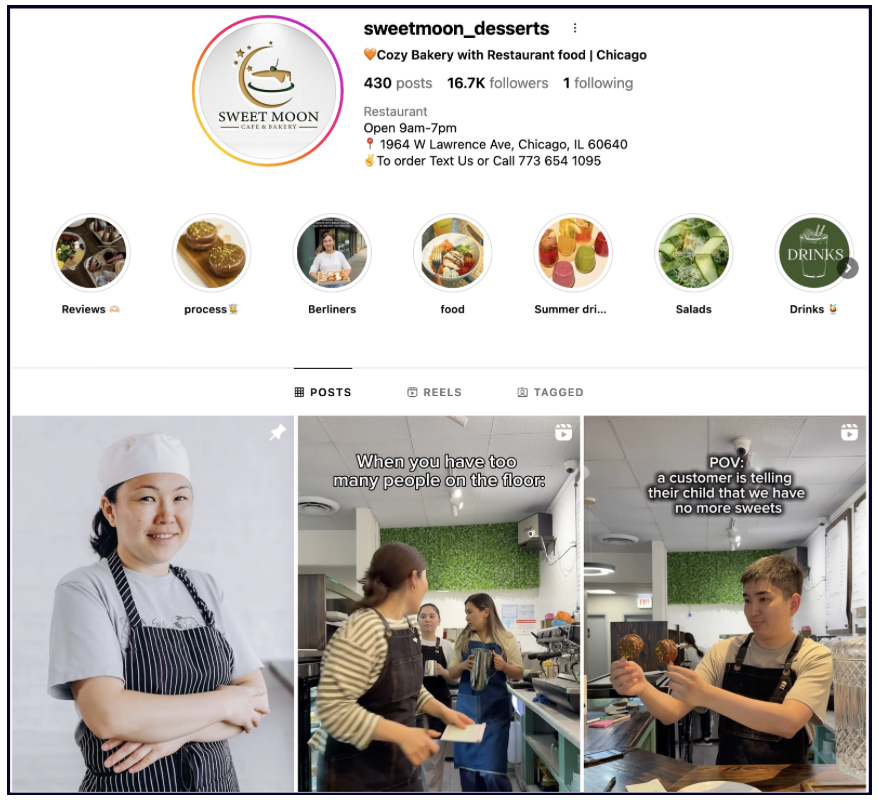
The popularity of specific social media platforms ebbs and flows over time, meaning that no local business should ever tie too much of its marketing plan to any one community. Rather, a good plan is to research which sites appear to be most popular in both the geographic region and industry of the business you’re marketing and devote time and budget to building a community across a couple of select environments.
For example, a business with a highly-appealing visual component (like a boutique bakery) may find its strongest community of supporters on Instagram, while a service area business (like a small plumbing chain) may build more authority by filming their projects for a YouTube channel. Traditional social media platforms you should consider investigating include:
In addition to these major social media brands, there are Q&A-style platforms like Quora, private social servers like Discord, and patron-based communities like Patreon and Substack. In some communities, old-fashioned local forums are still going strong and should not be overlooked.
If your small business has the budget, you can invest in audience research tools like SparkToro to help you optimize your social media marketing so that you’re spending time and money in the best channels for your company and community.
If you don’t currently have the resources for this sort of investment, find your top local competitors on social media and study which types of content they are publishing and how the public is responding. Couple this with polling your own customers and talking to your neighbors about where they like to spend time socializing online. Your creativity will be at a premium when brainstorming how to contribute something of value in the local online social setting.
Here are 4 good rules of thumb to keep in mind:
💡 Be sure to include linked social media icons on your website and listings like your Google Business Profiles.
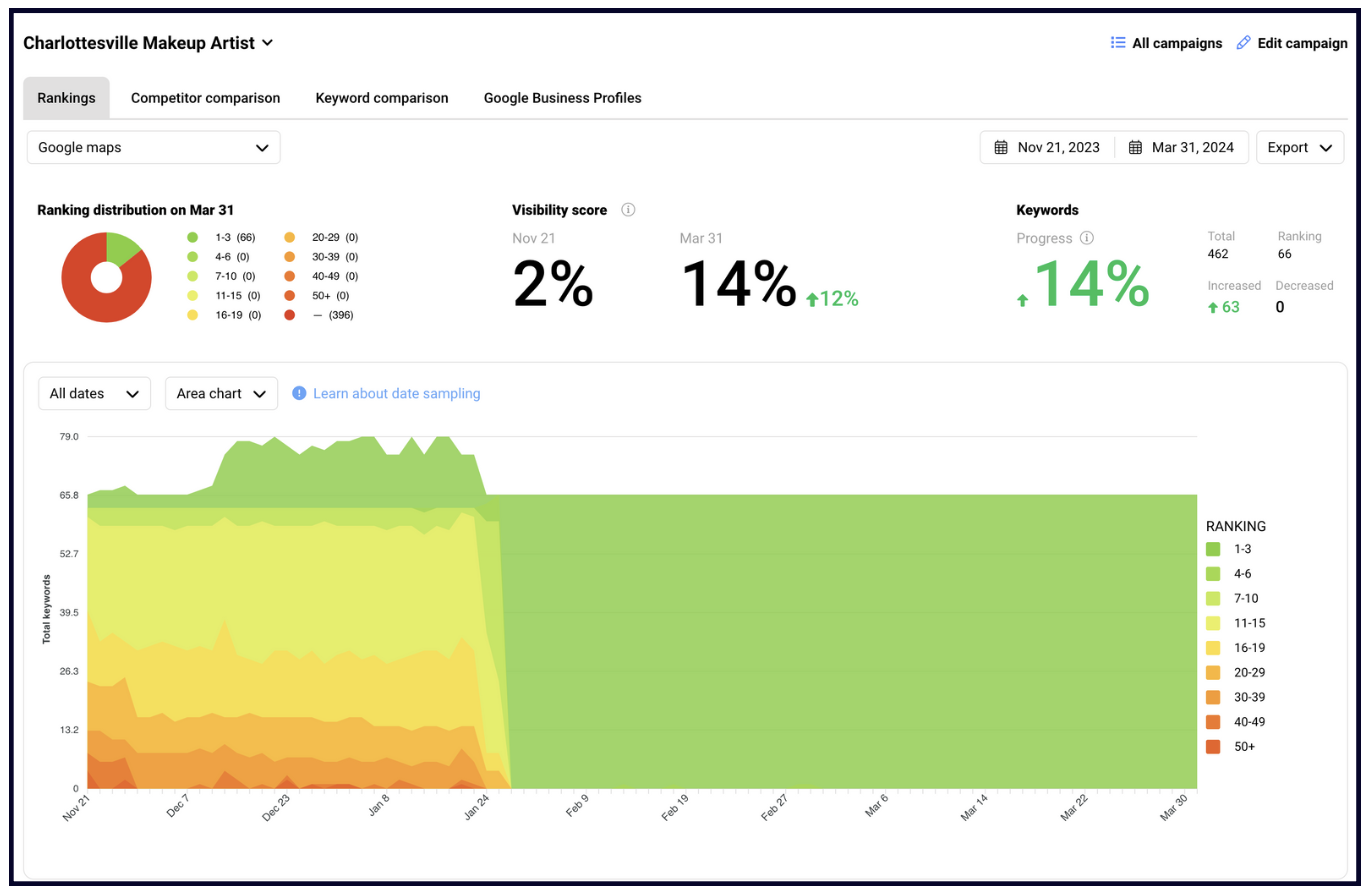
If you invest in local search marketing software, your provider will have a proprietary dashboard which reports on specific metrics meant to track your growth over time. Apart from this, most local businesses will want to hook their website up to:
Each company will have benchmarks and metrics that matter most to it, but some general markers you’ll want to track for local brands include:
It’s only by having a plan to track the performance of your varied marketing practices that you will know which activities are succeeding. While this overview of local search marketing opportunities is not a detailed tutorial for setting up analytics for local businesses, here are 3 best practices to keep in mind:
1. Don’t overemphasize local rankings in your reporting. As we covered at the beginning of this guide, Google heavily customizes their local search results based on the proximity of the searcher to the businesses nearest them.
❗ There are no #1 rankings in local search, and it is far better to think of overall visibility than to hyperfocus on ranking order.
2. Don’t run reports too often. There is an appropriate cadence for each business to run and analyze reports, but it’s vital to know that local search rankings change from hour to hour. Rather than placing too much importance on performance on a given day, look at trends over time to get a baseline sense of whether each branch of a local business is trending upwards or downwards in its most important metrics.
3. Don’t panic over sudden metrical drops. Sudden downshifts in metrics can be due to something as simple as a report having been run during the hours that a business was closed for the day, or they can be part of minor or major algorithmic updates, or even bugs. When you experience a drop, keep calm and check the local SEO news sources you trust most to see if others are reporting a similar phenomenon in the same time frame. If you suspect your Google Business Profile has been penalized by Google, read our guide to unverified vs. disabled vs. suspended GBPs to understand the steps available to you for recovery.
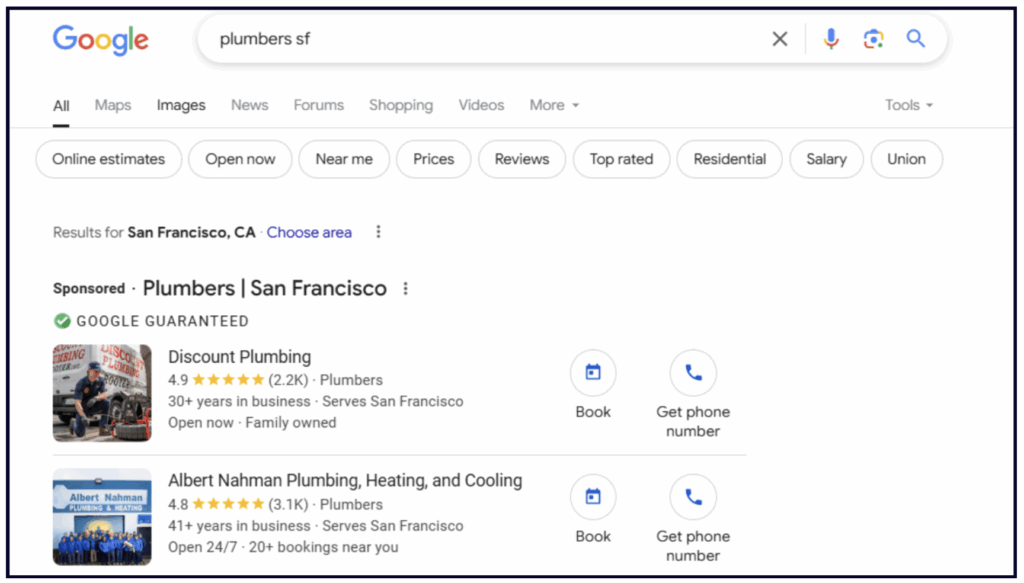
Every local business has the opportunity to invest in Google Ads to pay for visibility as part of their overall marketing plan. Additionally, participating in Google’s localized advertising program, Local Service Ads, has become a necessity in many local business verticals in which Google is highly featuring these paid results. As with any marketing effort, the investment only makes sense if it yields a good return, and the degree of investment should be predicated on the competitive level of the local market.
In many cases, truly small local businesses or companies operating in underserved rural areas will never need to spend a penny on paid advertising because they are one of the few nearby options which Google will be able to surface as relevant results for customers in these regions. In other cases, SMBs may choose to invest in other forms of paid media, such as sponsorships of community events or banner ads on popular local or industry sites. Where the market is highly competitive, however, wise investment may need to be made in a full Google Ads program plus additional paid media.
Study the advertising habits of your top local competitors to predict the level of investment you are likely to need to make, and don’t be afraid to hire experts to help you get the most from your advertising budget.
Now it’s time to take a break from this long hike we’ve been on. Good job getting here! You’ve become acquainted with the 12 major components that can be packed into a strong local search marketing plan, and you have a clear vista of the opportunities that lie before you.
Don’t worry if you feel a little overwhelmed by just how many routes you could start hiking tomorrow with all this information. Local search marketing never happens all at once, but is best thought of as a step-by-step walk you take every day doing thoughtful work for the businesses you promote with the goal of better serving customers. Even small improvements made over time can deliver meaningful growth in impressions, traffic, rankings, reputation, conversions, and sales. It’s an endurance challenge, but one with real-world rewards.
Keep learning with Whitespark. Our guides are here to help you, and our team is here to serve you.
Miriam Ellis is a local SEO columnist and consultant. She has been cited as one of the top five most prolific women writers in the SEO industry. Miriam is also an award-winning fine artist and her work can be seen at MiriamEllis.com.
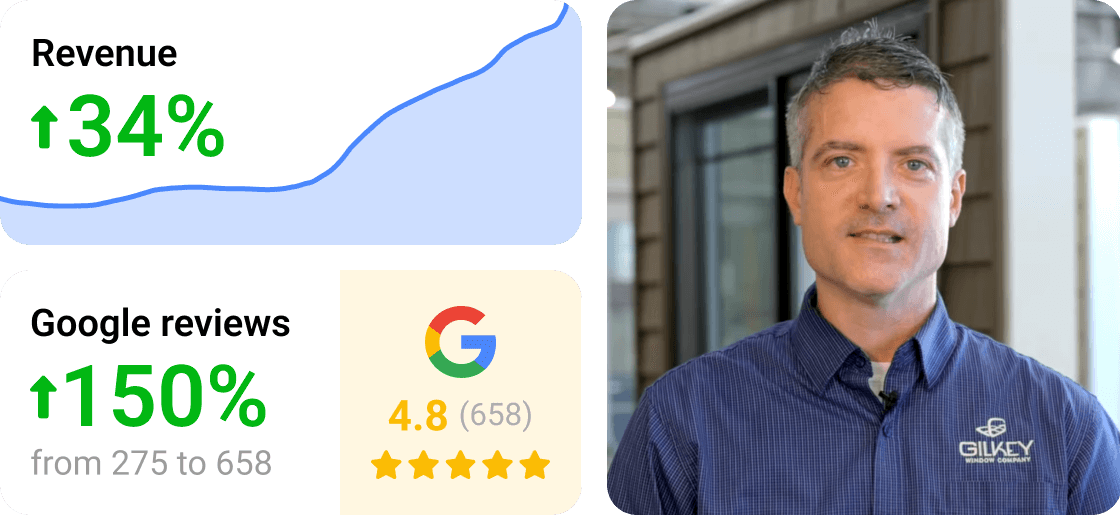

Whitespark provides powerful software and expert services to help businesses and agencies drive more leads through local search.
Founded in 2005 in Edmonton, Alberta, Canada, we initially offered web design and SEO services to local businesses. While we still work closely with many clients locally, we have successfully grown over the past 20 years to support over 100,000 enterprises, agencies, and small businesses globally with our cutting-edge software and services.